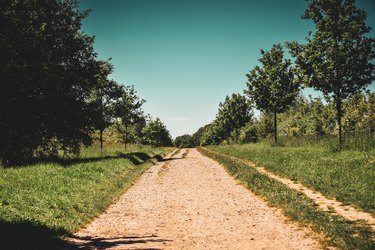
If your garden path has a few uneven spots or areas where the ground isn't level, choosing the right material for your landscape path ideas, such as mulch or gravel, can help prevent falls by providing traction or at least awareness of the ground. In contrast, allowing the path to be overrun with grass or other groundcover hides dips and hills, making tripping more likely. Constructing an actual walkway has the added advantage of providing room for rain runoff, so the area won't be muddy in damp weather. Structure-type walkways aren't suitable for uneven ground because they can warp and fail over time as the ground settles, but loose materials can adapt.
Loose Fill Walkway
Video of the Day
The term "loose fill" refers to any walkway material that you basically dump and spread into place. Gravel is very common, but river stones, granite or marble chips, crushed shells and lava stones are other options that add a sense of style. It's important to have a barrier to keep the loose fill material in place, so install edging along the borders of the walkway to keep it neat. Using loose fill for your backyard walking path provides excellent drainage and will shift if the ground changes.
Video of the Day
Mulch Walkway Benefits
Mulch is a good choice if there's no definite border between path and garden. Mulch also provides drainage, but offers a sturdier surface than loose fill because it tends to be somewhat stationary once it's tamped down. It will, however, accommodate shifting ground.
Keep in mind that mulch must be replaced periodically as it biodegrades, so it can get pricey for large areas in damp climates. Rubber mulch is an option if you need a softer surface — it's more expensive than wood mulch, but it provides a soft enough landing surface that it's frequently used in playgrounds to cushion falls.
Stepping Stone Walkway
Stepping stones don't cover and fill uneven ground the way gravel or mulch do, but they call your attention to good places to put your feet on uneven ground. Stepping stones may not be the best solution for extreme variations in terrain, and they must be placed no more than a natural step's-length apart. Slate, limestone, sandstone and coral are all common materials to bring your yard path ideas to life, but you can make your own stepping stones with plaster of Paris — this is a good idea if you require an odd size or shape, or if you wish to embed marbles or other decorative elements.
Brick Walkway Ideas
Brick walkways toe the line between structure and loose materials. Mortared brick is more structure than loose, and is only suitable if you terrace-out uneven terrain for a more definite grade. Otherwise, loose brick will cover the ground better, and can level out many areas of slight uneveness.
Have this done by a professional who knows how to pack the ground then lay the bricks securely enough that they stay in place. Doing this yourself will likely result in wobbly bricks that may cause more trips and falls than the uneven ground they're covering.